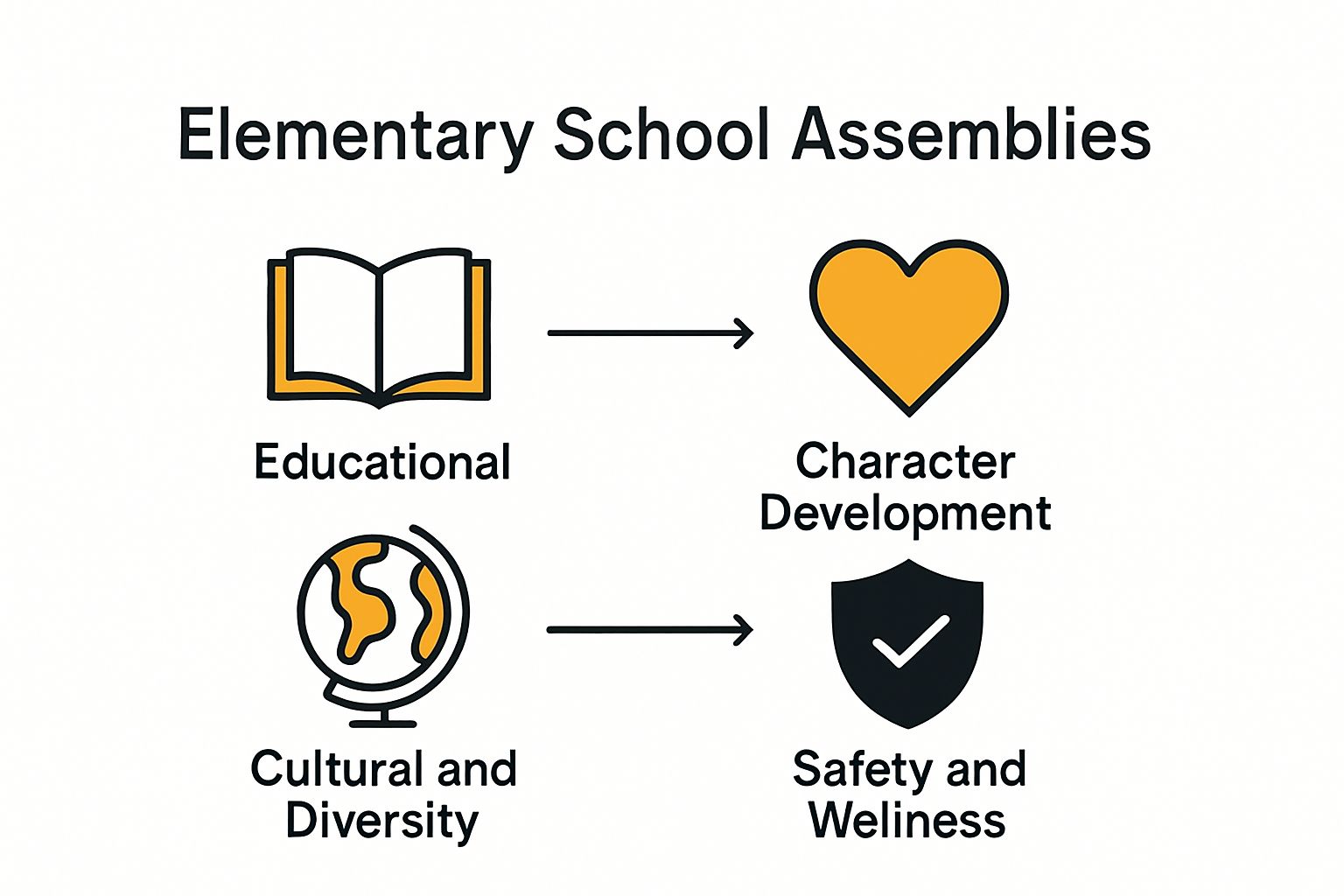School assemblies might seem like a simple break from class, but they actually shape the way students learn and connect. Most people think these gatherings are just routine announcements or performances. But when you discover that students who attend regular, positive assemblies show noticeable improvements in empathy, communication, and problem solving, those everyday meetings start to look a lot more powerful.
Table of Contents
- Defining Assemblies: What Are They?
- Why Assemblies Matter In Elementary Education
- How Assemblies Promote Community And Engagement
- Key Elements Of Successful School Assemblies
- Real-World Impact Of Assemblies On Students
Quick Summary
| Takeaway | Explanation |
|---|---|
| School assemblies build community | They foster shared experiences among students, enhancing school spirit and identity through collective participation. |
| Assemblies promote social and emotional growth | These events provide environments for students to develop interpersonal skills and emotional intelligence across different grade levels. |
| Diverse assembly types enhance learning | Different formats, like educational and cultural assemblies, offer students exposure to varied perspectives and subjects beyond the classroom. |
| Effective assemblies require careful planning | Success hinges on tailored content, engaging presentations, and logistical preparation to create meaningful experiences for students. |
| Assemblies connect academic and real-world experiences | They introduce practical applications of learning, bridging the gap between curriculum and real-life relevance to stimulate student interest. |
Defining Assemblies: What Are They?
School assemblies represent collective gatherings where students from various grade levels come together in a shared space, typically a gymnasium or auditorium, to participate in group activities, receive important information, or experience special presentations. These structured events play a significant role in elementary education, serving multiple purposes beyond simple information sharing.
The Purpose of School Assemblies
At their core, school assemblies are designed to create a sense of community and shared experience among students. Learn more about our unique assembly approaches that transform these gatherings from mundane meetings into engaging educational experiences. These gatherings accomplish several critical objectives:
- Building school spirit and collective identity
- Providing opportunities for large group learning
- Introducing students to diverse perspectives and experiences
Typically, elementary school assemblies can range from 30 minutes to an hour and involve entire student populations or specific grade levels. They might feature guest speakers, performances, educational presentations, recognition ceremonies, or interactive demonstrations that capture students attention and promote learning beyond traditional classroom settings.
Types of Elementary School Assemblies
Assemblies come in various formats, each serving unique educational and developmental goals. Some common types include:
- Educational Assemblies: Focused on specific academic topics or subjects
- Character Development Assemblies: Addressing social skills, emotional intelligence, and ethical behavior
- Cultural and Diversity Assemblies: Introducing students to different cultures, traditions, and global perspectives
- Safety and Wellness Assemblies: Teaching important health, safety, and prevention strategies
These gatherings are not merely interruptions to regular classroom schedules but strategic educational interventions designed to supplement traditional learning environments.
The following table categorizes the main types of elementary school assemblies described in the article, summarizing their core focus and key objectives for students.
| Assembly Type | Core Focus | Key Objectives |
|---|---|---|
| Educational Assemblies | Academic subjects and learning | Introduce new topics, enhance subject knowledge, connect with curriculum |
| Character Development Assemblies | Social and emotional skills | Promote ethical behavior, build empathy, teach conflict resolution |
| Cultural and Diversity Assemblies | Cultural awareness | Expose students to diverse traditions, foster inclusivity and broad perspectives |
| Safety and Wellness Assemblies | Health and safety education | Teach healthy habits, prevent risky behaviors, promote student well-being |
 By creating shared experiences and presenting information in dynamic, engaging ways, assemblies help elementary students develop broader understanding, critical thinking skills, and a sense of community within their school environment.
By creating shared experiences and presenting information in dynamic, engaging ways, assemblies help elementary students develop broader understanding, critical thinking skills, and a sense of community within their school environment.
Why Assemblies Matter in Elementary Education
Elementary school assemblies are far more than simple gatherings. They represent strategic educational opportunities that contribute significantly to students comprehensive development. Discover the multiple benefits of school assemblies that extend well beyond traditional classroom learning environments.
Social and Emotional Learning Opportunities
Assemblies provide unique platforms for social and emotional skill development. Unlike traditional classroom settings, these collective experiences allow students to interact across grade levels, observe diverse perspectives, and develop critical interpersonal skills. Students learn important lessons about listening, respecting different viewpoints, and participating constructively in group settings.
Expanding Educational Horizons
These gatherings introduce students to learning experiences that transcend standard curriculum boundaries. Key educational expansion benefits include:
- Exposure to specialized experts and professionals
- Interactive learning demonstrations
- Opportunities to explore subjects beyond textbook content
- Introduction to complex topics through engaging presentations
By bringing external perspectives into the school environment, assemblies help students connect academic learning with real world applications. Complex subjects become more accessible and engaging when presented through interactive, dynamic formats that capture young learners attention.
Building School Community and Culture
Assemblies serve as powerful tools for cultivating school identity and collective spirit. They create shared experiences that bind students together, reinforcing positive behavioral expectations and school values. Through recognition ceremonies, performance showcases, and collaborative activities, elementary schools can strengthen their institutional culture and provide students with a sense of belonging.

Ultimately, school assemblies represent more than interruptions to regular academic schedules. They are intentional educational interventions designed to support holistic student development, offering rich opportunities for learning, personal growth, and community building.
How Assemblies Promote Community and Engagement
Elementary school assemblies serve as powerful mechanisms for fostering student engagement, creating meaningful connections, and building a vibrant school community. Learn more about interactive assembly experiences that transform traditional school gatherings into dynamic learning opportunities.
Breaking Down Social Barriers
Assemblies provide unique environments where students from different grades, backgrounds, and social groups can interact in structured yet relaxed settings. These gatherings help break down social barriers by creating shared experiences that transcend typical classroom interactions. According to research from the National Institutes of Health, collective experiences significantly enhance students ability to develop empathy and understanding across diverse groups.
Collaborative Learning and Participation
These group events encourage active participation and collaborative learning through various engagement strategies:
- Encouraging group responses and collective activities
- Providing opportunities for student recognition
- Creating platforms for shared emotional experiences
- Developing listening and observation skills
Engagement goes beyond passive observation, transforming students from silent recipients to active participants in their educational journey. By designing assemblies that invite interaction, schools create environments where students feel valued, heard, and connected to their broader school community.
Strengthening Institutional Identity
Regular assemblies play a critical role in establishing and reinforcing school culture. They serve as ceremonial touchpoints that communicate institutional values, celebrate achievements, and create a sense of collective identity. Through carefully crafted presentations, performances, and group activities, schools can communicate core messages about respect, diversity, academic excellence, and personal growth.
By intentionally designing assemblies that are inclusive, interactive, and meaningful, elementary schools can create powerful platforms for community building that extend far beyond traditional educational approaches.
Key Elements of Successful School Assemblies
Designing effective elementary school assemblies requires careful planning and strategic execution. Check out our comprehensive assembly planning guide to ensure your events are engaging and impactful for students.
Age-Appropriate Content and Delivery
Successful assemblies must be meticulously tailored to match students developmental stages and cognitive capabilities. Young learners have shorter attention spans and require dynamic, interactive presentations that maintain their interest. Content complexity and presentation style must align with students comprehension levels, ensuring that information is both accessible and stimulating.
Engaging Presentation Strategies
Effective assemblies incorporate multiple engagement techniques to capture and maintain student attention:
- Using multimedia visual presentations
- Incorporating interactive storytelling
- Encouraging audience participation
- Integrating humor and age-appropriate entertainment
- Utilizing varied vocal tones and dramatic presentation styles
Presenters must create an atmosphere of excitement and curiosity, transforming educational content into memorable experiences. The goal is to make learning feel like an adventure rather than a mandatory activity.
Practical Preparation and Logistics
Behind every successful assembly lies meticulous preparation. School administrators and teachers must consider several critical logistical elements:
- Selecting appropriate venue spaces
- Managing student seating arrangements
- Ensuring technical equipment functionality
- Coordinating smooth transitions between activities
- Preparing backup plans for potential disruptions
By anticipating potential challenges and creating structured frameworks, schools can minimize distractions and maximize learning opportunities. The most successful assemblies feel seamless and intentional, providing students with enriching experiences that complement their regular academic curriculum.
This table highlights the key elements needed for successful school assemblies, outlining the characteristic, its importance, and practical considerations drawn directly from the article.
| Key Element | Importance | Practical Considerations |
|---|---|---|
| Age-Appropriate Content and Delivery | Keeps students engaged and ensures comprehension | Match developmental stage, use interactive formats, tailor language |
| Engaging Presentation Strategies | Captures attention and increases participation | Use visuals, storytelling, humor, audience participation |
| Practical Preparation and Logistics | Ensures events run smoothly | Choose venue, manage seating, check equipment, plan transitions |
Ultimately, successful school assemblies are not about perfect execution but about creating meaningful, engaging moments that inspire, educate, and connect students in profound and memorable ways.
Real-World Impact of Assemblies on Students
Elementary school assemblies extend far beyond momentary entertainment, representing powerful catalysts for student development and learning. Explore transformative assembly experiences that create lasting educational impressions on young learners.
Academic and Social Skill Development
Assemblies function as critical platforms for developing essential academic and social competencies. These collective experiences help students build skills that traditional classroom settings might not effectively address. According to research from SAGE Journals, students who participate in regular positive school assemblies demonstrate significant improvements in interpersonal communication, empathy, and collaborative problem solving.
Psychological and Emotional Benefits
The psychological impact of well-designed assemblies can be profound and multifaceted. These experiences contribute to students emotional intelligence and overall psychological well being through:
- Creating safe environments for exploring complex emotions
- Providing opportunities for collective emotional experiences
- Reinforcing positive behavioral expectations
- Developing strategies for managing social interactions
- Promoting individual and group self reflection
Emotional learning becomes experiential, transforming abstract concepts into tangible understanding through shared group experiences. Students learn to recognize, understand, and appropriately respond to diverse emotional scenarios.
Long Term Personal Growth
Assemblies serve as foundational experiences that shape students perspectives and personal development trajectories. By introducing diverse topics, celebrating achievements, and modeling positive behaviors, these gatherings help students:
- Develop broader worldviews
- Understand complex social concepts
- Build resilience and adaptability
- Recognize individual and collective potential
- Create meaningful connections beyond immediate peer groups
Through carefully curated assembly experiences, elementary schools can profoundly influence students cognitive, emotional, and social growth, preparing them for more complex interpersonal and academic challenges in their educational journey.
Transform Your School Community With Unforgettable Assemblies
Are you searching for ways to harness the true power of school assemblies and bring transformational experiences to your students? The article highlighted that assemblies are not just meetings, but crucial opportunities to build community, support social and emotional learning, and expand student horizons. Yet, many schools struggle to find assembly programs that are truly engaging, age-appropriate, and tied to core values like diversity, character development, and wellness.

Bring excitement and deeper learning to your school with Academic Entertainment’s expertly crafted assembly programs. Choose from a wide range of live and virtual shows that reinforce your school themes and address the goals discussed in the article, from anti-bullying to creativity. Our platform offers hands-on guidance and proven providers with decades of experience. Ready to make your next assembly impactful? Explore our unique assembly experiences and book a program that will truly connect with your students. Visit https://academicentertainment.com today and start planning an unforgettable school event that inspires every learner.
Frequently Asked Questions
What are the primary purposes of assemblies for elementary students?
Assemblies serve to build school spirit, provide large group learning opportunities, and introduce students to diverse perspectives. To maximize the benefits, schools should plan assemblies carefully to align with educational goals and themes.
How can assemblies support social and emotional learning in elementary students?
Assemblies offer unique platforms that encourage students to interact across different grades, fostering empathy and communication skills. To create such opportunities, schools should design engaging activities that promote collaboration and respectful dialogue.
What types of assemblies are most beneficial for elementary students?
Common beneficial types of assemblies include educational, character development, cultural diversity, and safety wellness assemblies. Schools should assess their student population’s needs and rotate these assembly types to maintain engagement and relevance.
How can schools ensure that assembly content is age-appropriate?
Successful assemblies should be tailored to match the developmental stages and comprehension levels of students. When planning, educators should consider using engaging visuals and interactive elements that resonate with young learners to keep their attention.
What logistical considerations should be taken into account when planning an assembly?
Key logistical considerations include selecting appropriate venues, managing student seating, ensuring technical equipment functionality, and planning smooth transitions between activities. Organizing these elements effectively will help create a seamless experience for students.
How can schools measure the impact of assemblies on student development?
Schools can evaluate the impact of assemblies by tracking improvements in social skills, emotional well-being, and engagement levels over time. Implementing feedback mechanisms, such as surveys or small group discussions following assemblies, can provide valuable insights into their effectiveness.




